Welcome to exploring the 10 best beautiful places in Kanazawa, a city where tradition meets modernity and every corner offers a story.
Known for its well-preserved Edo-era districts, vibrant contemporary art scene, and stunning gardens, Kanazawa invites travelers to discover its unique blend of history and innovation.
Join us as we delve into the must-visit spots that showcase the best of Kanazawa’s cultural heritage and natural beauty.
This guide will take you through the city’s most picturesque and inspiring locations, from ancient samurai residences to cutting-edge museums.
- Recommended BEST Tours in Kanazawa
- Recommended Kanazawa Hotels
- Cheap Flights, Airline Tickets & Plane Tickets (TRIP.COM)
Number 10: Nagamachi Samurai District.
Starting at number 10, the Nagamachi Samurai District stands as a beautifully preserved window into Japan’s storied past, located in the heart of Kanazawa. This historic area is famous for its atmospheric, narrow lanes and earthen walls that encase the residences where samurai and their families once lived during the Edo period.
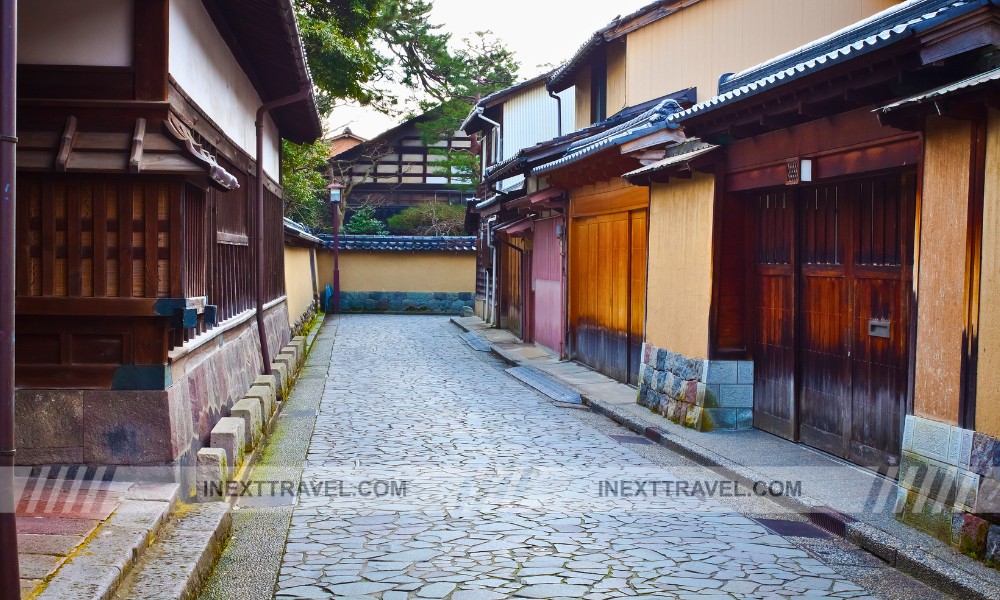
Walking through Nagamachi today feels like stepping back in time, as much of the district’s original architectural style and layout have been meticulously maintained, reflecting the lifestyle and culture of the samurai class.
The area is characterized by its traditional “nagaya” samurai houses, which are distinguished by their tiled roofs and mud walls. Many of these residences have been converted into museums, such as the Nomura-ke, which allow visitors to explore the inside of a samurai house and view artifacts from the era, including armor, weapons, and personal items.
The carefully curated gardens of these residences are another highlight, featuring manicured landscapes with koi ponds and stone lanterns, which exemplify the samurai’s deep connection to aesthetics and nature.
Additionally, the district is intersected by charming water canals, which were initially built for drainage and defense but now add to the area’s scenic beauty. These canals and the stone-paved streets contribute to Nagamachi’s serene atmosphere, making it a perfect place for a peaceful stroll.
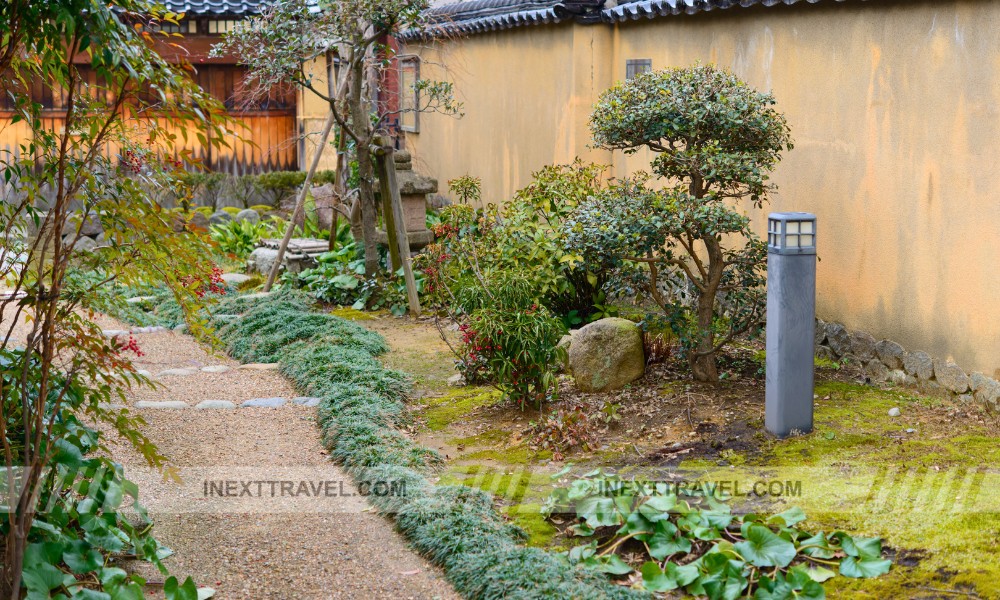
Visitors to the Nagamachi Samurai District can also enjoy various traditional tea houses and local craft shops that line the streets, offering a taste of authentic Kanazawa hospitality and culture. The district provides a glimpse into the samurai’s life and actively preserves the traditions of their era, allowing for a deeper understanding of the cultural heritage that shaped Japan.
In summary, the Nagamachi Samurai District is a captivating historical site that offers a unique and immersive experience of Japan’s feudal past. It preserves not just the physical structures but also the spirit of the samurai era, making it a must-visit for anyone interested in Japanese history and traditional culture.
Number 9: Nomura Family Samurai House.
At number 9, we invite you to step inside the Nomura Family Samurai House, a remarkably preserved residence that offers a vivid window into the life and culture of a samurai family in Kanazawa.
This historic house is an architectural gem and a reflection of the deep-rooted bushido spirit, characterized by the virtues of honor, discipline, and loyalty that defined the samurai class.
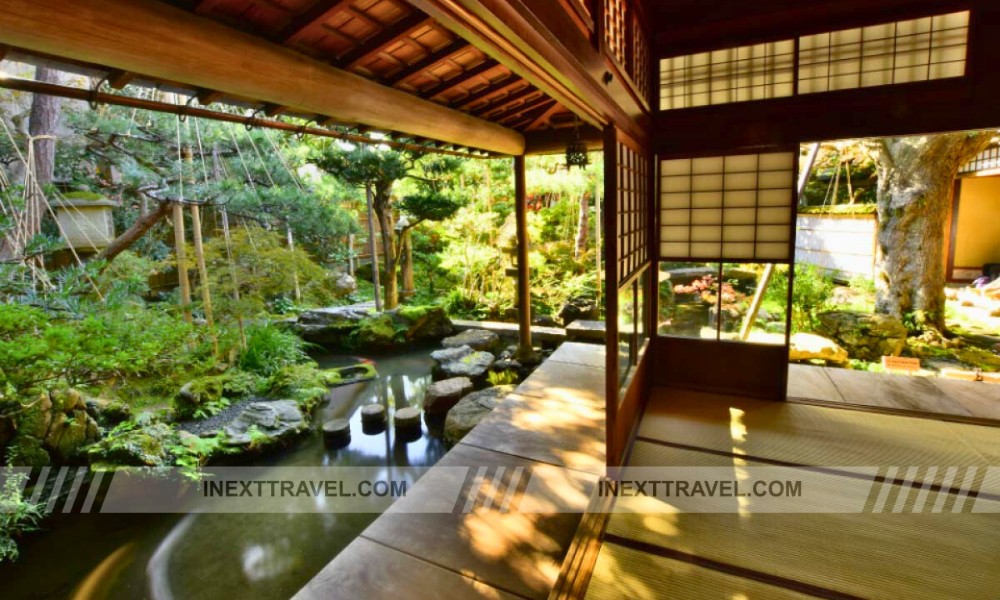
The Nomura Samurai House is nestled in the heart of the Nagamachi Samurai District and stands out for its exquisite design and meticulous preservation. Visitors are greeted by thick earthen walls and a heavy wooden gate that leads into a tranquil world away from the hustle of modern life.
The house’s architecture is a splendid example of samurai residences from the Edo Period. It features tatami rooms, sliding fusuma doors decorated with elegant paintings, and dark wooden beams that contrast beautifully with the soft natural light filtering through shoji screens.
One of the house’s most breathtaking features is its traditional Japanese garden, visible through large windows that blend the indoor and outdoor spaces.
This garden is a masterpiece of landscape design, incorporating elements such as a koi pond, stone lanterns, manicured trees, and a small, flowing waterfall. Each component is carefully placed to create a scene of natural beauty that promotes contemplation and peace, embodying the aesthetic values and philosophical principles cherished by the samurai.
Inside, the house showcases various artifacts and personal belongings of the Nomura family, including armor, swords, and family crests, which tell stories of the family’s heritage and social status.
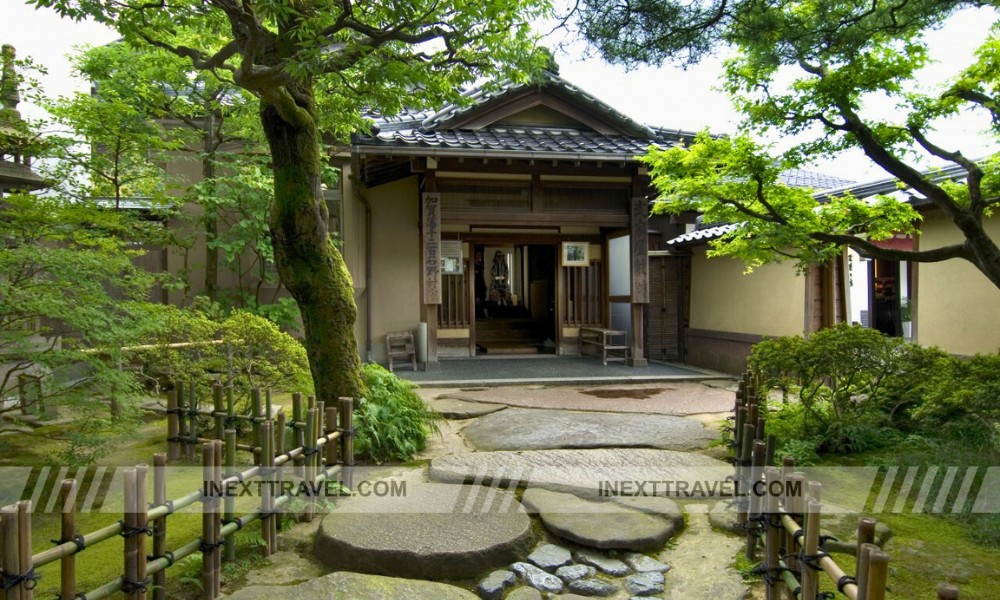
Additionally, the house displays a collection of art and calligraphy, reflecting the samurai’s cultural pursuits and artistic sensibilities. These exhibits provide a deeper understanding of the complexities of samurai life, revealing a culture that highly valued martial prowess and artistic refinement.
The Nomura Family Samurai House serves as a museum and a poignant reminder of a bygone era. It offers visitors a comprehensive experience of the samurai’s aesthetic and moral universe.
Walking through its rooms and gardens, one can almost hear the echoes of the past, making it an essential visit for anyone seeking to understand the samurai’s true spirit and Kanazawa’s historical fabric.
Number 8: Kanazawa Castle Park.
At number 8, we explore the expansive and historical Kanazawa Castle Park, which blends architectural grandeur with lush natural beauty. Once the seat of the powerful Maeda clan during the feudal era, this castle has been a critical fixture in Kanazawa’s cultural landscape for centuries. Today, it serves as a public park, offering a peaceful retreat with its vast open grounds, reconstructed buildings, and beautifully maintained gardens.
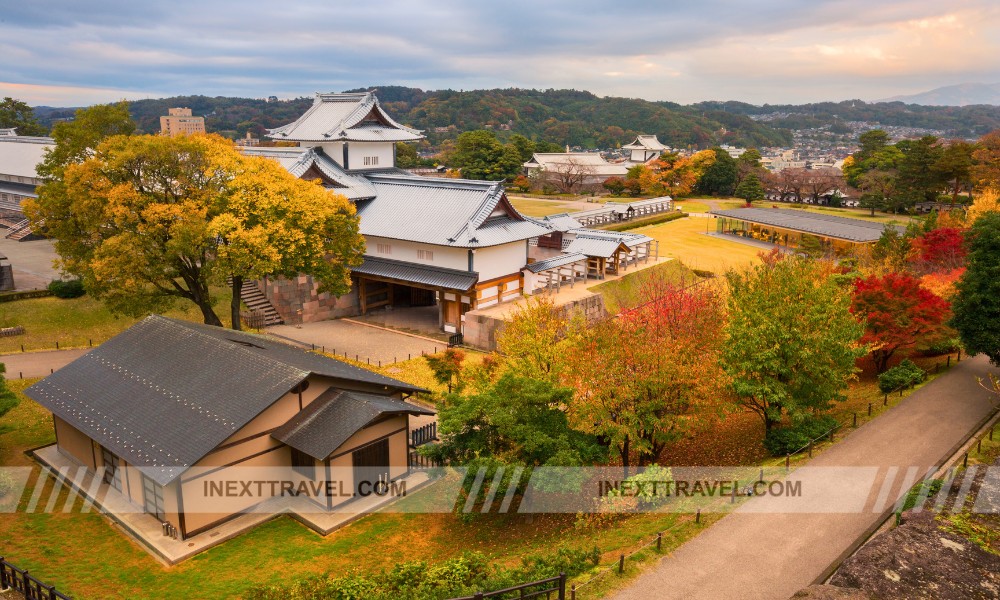
Kanazawa Castle is a marvel of traditional Japanese architecture, reconstructed using historical techniques to preserve its original appearance. The Ishikawa-mon Gate, an important cultural property, stands as a striking entrance to the castle, showcasing the defensive yet elegant design characteristic of samurai fortifications.
The Hishi Yagura, Gojikken Nagaya, and Hashizume-mon Tsuzuki Yagura watchtowers have been meticulously rebuilt, giving visitors a glimpse into the castle’s strategic importance and architectural ingenuity.
The park surrounding the castle structures is equally impressive, featuring a variety of gardens that change dramatically with the seasons. The Gyokusen’inmaru Garden, for example, is a stunning landscape garden complete with a central pond, streams, and a waterfall, all carefully designed to reflect the refined aesthetic principles of Japanese garden art.
In spring, cherry blossoms frame the castle’s stone walls and turrets, creating a breathtaking canopy of pink and white. Autumn brings a vibrant palette of red, orange, and yellow leaves, providing a picturesque contrast against the grey castle walls and green lawns.
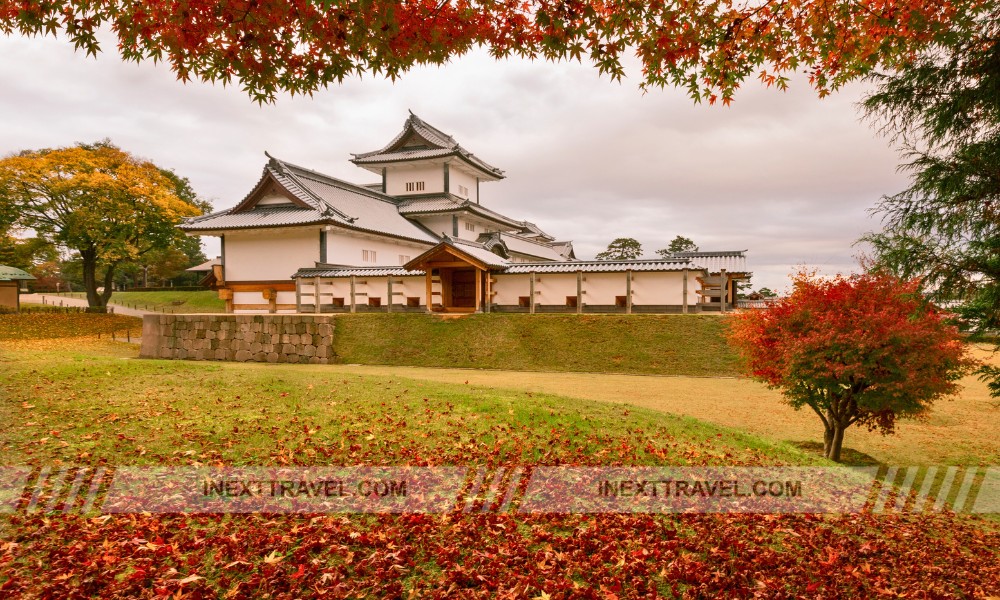
Beyond its beauty, Kanazawa Castle Park serves as a cultural hub, hosting various events and festivals throughout the year that celebrate the park’s history and seasonal transformations. These events range from traditional tea ceremonies in the garden teahouses to dramatic reenactments of historical events, allowing visitors to engage directly with Kanazawa’s rich cultural heritage.
Kanazawa Castle Park is a relic of the past and a living part of the city, continually adapting to meet residents’ and tourists’ cultural and recreational needs. Whether you are a history enthusiast, a lover of natural beauty, or simply seeking a tranquil space to unwind, Kanazawa Castle Park offers a diverse array of attractions that make it a must-visit destination in the city. Its historical significance, architectural beauty, and seasonal charm make it a standout feature of Kanazawa, capturing the essence of the city’s storied past and vibrant present.
Number 7: Gyokusen’inmaru Garden.
At number 7 is Gyokusen’inmaru Garden, a captivating and historically significant part of Kanazawa Castle’s extensive grounds. Originally designed as the castle’s outer garden, this exquisite space has been transformed into a public oasis that embodies the delicate artistry of Japanese garden design and the deep-rooted appreciation for nature found in traditional Japanese culture.
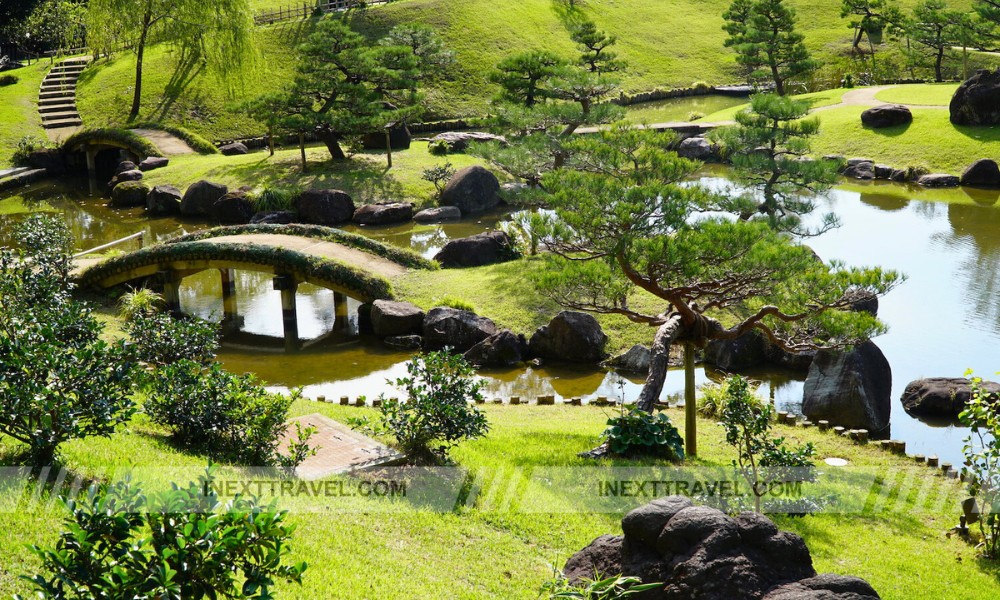
Gyokusen’inmaru Garden is a masterpiece of landscaping. It features an intricate network of streams and ponds interwoven with carefully arranged rocks and elegantly pruned trees. Central to the garden’s design is a large pond that mirrors the sky and surrounding foliage, creating a tranquil and reflective environment.
The paths that meander through the garden lead visitors on a journey through varied scenery. Each turn and crossing is designed to reveal a new perspective or hidden beauty, encouraging slow, contemplative walks.
One of the most magical times to visit Gyokusen’inmaru Garden is during the evening light-up events, which are held seasonally. During these events, the garden is illuminated by soft lights that highlight the shapes and textures of the trees and landscape features.
The lights cast serene reflections on the water, creating an enchanting atmosphere that feels like stepping into another world. The gentle lighting enhances the garden’s natural beauty while adding a layer of mystique and romance, making it a popular spot for locals and tourists.
The garden is a place of aesthetic and recreational value and a cultural venue where visitors can experience traditional Japanese activities and festivities. Throughout the year, the garden hosts tea ceremonies, art exhibitions, and seasonal festivals that celebrate its changing natural backdrop—from the vibrant blossoms of spring to the fiery autumn leaves.
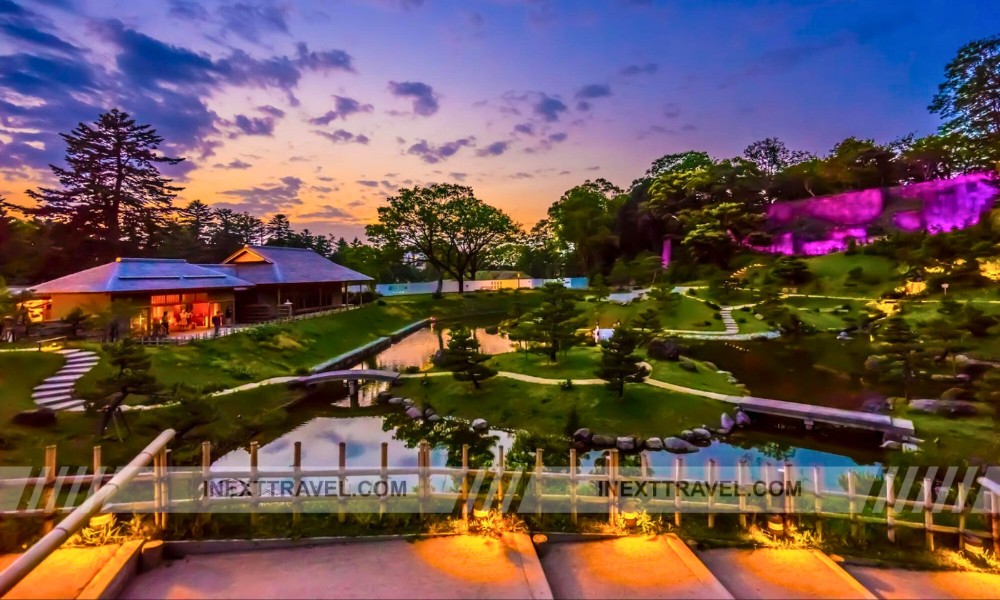
Gyokusen’inmaru Garden’s proximity to Kanazawa Castle also allows visitors to explore the area’s historical and architectural heritage, making it a comprehensive cultural experience. The garden serves as a peaceful retreat from the bustling city life, providing a space where history, art, and nature coexist harmoniously.
In conclusion, Gyokusen’inmaru Garden is more than just a scenic spot; it is a living piece of art and history that offers a serene escape and a deep connection to the traditional landscape aesthetics of Japan. Its beauty and tranquility make it a must-visit destination in Kanazawa for anyone looking to immerse themselves in Japanese culture and garden design.
Number 6: Omicho Market.
At number 6 is Omicho Market, affectionately known as Kanazawa’s Kitchen. This bustling marketplace is the epicenter of the city’s culinary scene and has served locals and tourists for over 280 years. With its vibrant atmosphere and an array of fresh produce, seafood, and local delicacies, Omicho Market offers a lively and authentic experience central to Kanazawa’s daily life.
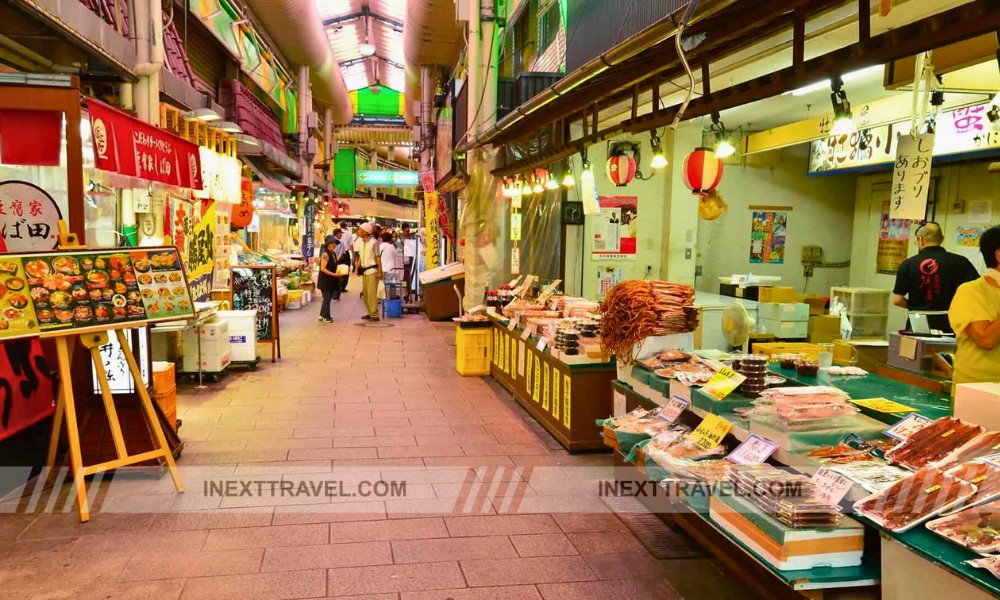
The market features over 200 shops and stalls specializing in Japanese cuisine and regional specialties. Given Kanazawa’s proximity to the Sea of Japan, seafood is a significant highlight.
Visitors can find stalls displaying tanks of live crabs, rows of neatly arranged fish, and vendors skillfully preparing sushi and sashimi from the catch of the day. This freshness is a hallmark of Omicho Market and a testament to its role in the local food culture.
Beyond seafood, the market also offers a diverse selection of fruits, vegetables, meats, and sweets. Many stalls sell Kanazawa’s famous Kaga vegetables, a group of traditional vegetables unique to the region, known for their exceptional taste and quality. The market is also a great place to sample and buy local specialties such as Kanazawa curry, gold leaf ice cream, and handmade mochi, providing a taste of the region’s culinary diversity.
Omicho Market is more than just a place to buy food; it’s a bustling social hub where visitors can interact with friendly locals and learn about the food culture of Kanazawa. Many vendors are happy to share recipes or cooking tips, enhancing the shopping experience with a personal touch. The market’s lively, open-air corridors are lined with small restaurants and eateries where shoppers take breaks to enjoy freshly prepared meals, often featuring ingredients sourced directly from the market stalls.

The market’s architecture, covered streets, and organized chaos add charm and make the shopping experience comfortable regardless of the weather. This setup protects patrons from rain or snow and helps preserve the fresh produce and seafood displayed by vendors.
In conclusion, Omicho Market is a vibrant and essential part of Kanazawa, providing an immersive way to experience the local culture and cuisine. For anyone visiting Kanazawa, a trip to Omicho Market is a must-do, offering a chance to explore this fascinating region’s rich flavors and traditions while enjoying the lively atmosphere that makes this market the heart of Kanazawa’s culinary scene.
Number 5: Kanazawa Phonograph Museum.
At number 5, the Kanazawa Phonograph Museum presents a fascinating and unique cultural experience unlike any other city. This niche museum offers a nostalgic journey back to the early days of sound recording, showcasing an extensive and meticulously curated collection of phonographs, gramophones, and thousands of vintage records. Located in a quaint area of Kanazawa, the museum not only captivates visitors with its historical displays but also enchants them with the warm, crackling sound of music from bygone eras.

The museum’s collection spans from the late 19th century to the mid-20th century, featuring a variety of phonographs and gramophones, from the earliest Edison models to more elaborate, decorative pieces that reflect the technological and design evolution of sound recording devices. Each phonograph is accompanied by informational plaques detailing its history, mechanics, and cultural significance, providing visitors with a comprehensive understanding of how these devices changed how people experienced music and spoken word.
One of the highlights of visiting the Kanazawa Phonograph Museum is the live demonstrations. The museum staff regularly plays records on some of the antique machines, allowing visitors to experience the authentic sound quality and operation of these historical devices. These demonstrations bring the exhibits to life and illustrate the technical ingenuity of the past.
Additionally, the museum offers a deeper look into the cultural impact of phonographs on society, exploring how the accessibility of recorded sound influenced popular culture, music distribution, and even the preservation of languages and traditions. The collection of vintage records includes a wide range of genres and languages, representing the global reach and cultural diversity of phonograph music.
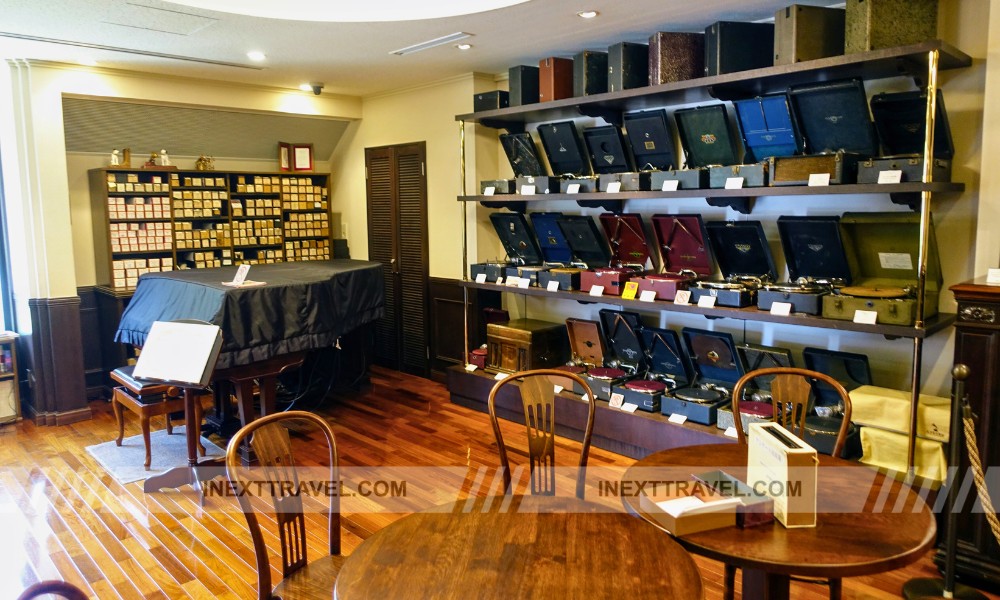
The intimate setting of the museum, with its warm wooden interiors and shelves lined with old records, creates a welcoming atmosphere that invites visitors to linger and explore. The Kanazawa Phonograph Museum also includes a cozy listening area where guests can request to hear specific records, from classical music to early jazz, offering a personal and immersive auditory experience.
In conclusion, the Kanazawa Phonograph Museum is a treasure trove for history buffs and music lovers. It provides a unique opportunity to step back in time and discover the origins and evolution of sound recording technology, all within the charming historical context of Kanazawa. This museum educates its visitors about technological history and celebrates the timeless beauty of listening to music spun from vintage records.
Number 4: D.T. Suzuki Museum.
At number 4, we find the D.T. Suzuki Museum, a serene and architecturally striking space dedicated to celebrating the life and teachings of Daisetsu Teitaro Suzuki, one of the most influential figures in bringing Zen Buddhism to the Western world. Located in Kanazawa, where Suzuki was born, the museum delves into his profound philosophical contributions and offers visitors a space for contemplation and reflection, embodying the very principles Suzuki espoused.
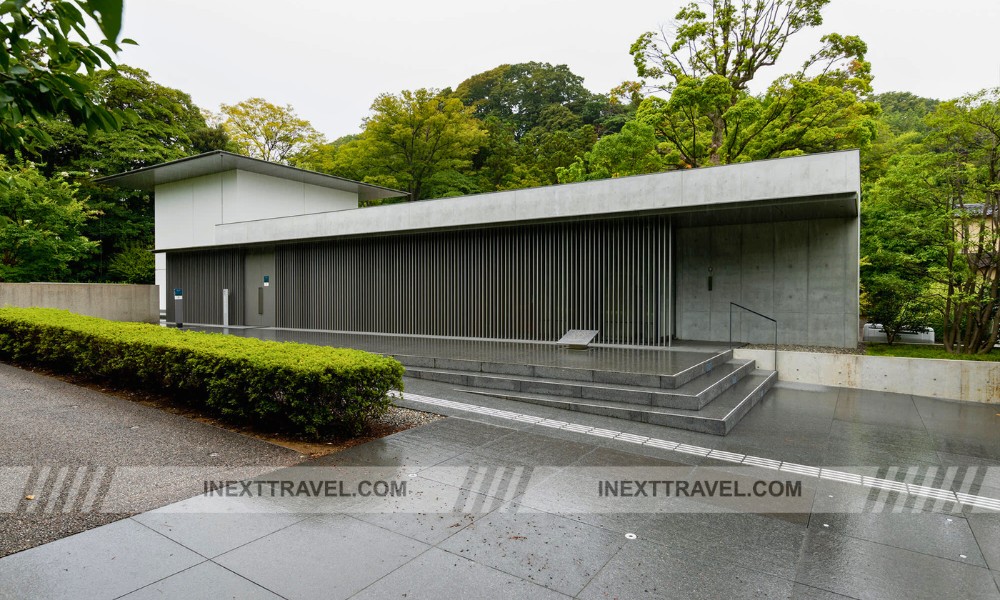
The museum’s design is a testament to Zen principles, featuring minimalist architecture that harmonizes beautifully with the natural surroundings. The complex has several sections, including the Exhibition Hall, the Contemplative Space, and the Water Mirror Garden. Each area is thoughtfully designed to facilitate a deeper understanding and connection with Zen philosophy. The Exhibition Hall contains a comprehensive collection of Suzuki’s writings, personal belongings, and scholarly works, providing insights into his life’s journey and the evolution of his thoughts.
The Contemplative Space is particularly unique. It is an open, airy room with large windows that look out onto the Water Mirror Garden, a tranquil garden featuring a large reflecting pool. This design encourages visitors to sit in quiet reflection, mirroring Suzuki’s meditation practice and mindful awareness. The simplicity and quiet of this space offer a profound experience of peace and introspection.
The museum also organizes various workshops, lectures, and meditation sessions, further enriching visitors’ understanding of Zen Buddhism and Suzuki’s teachings. These activities are designed to be accessible to everyone, from beginners to those with a deep interest in Buddhist philosophy, reflecting Suzuki’s commitment to sharing Zen insights with a broad audience.
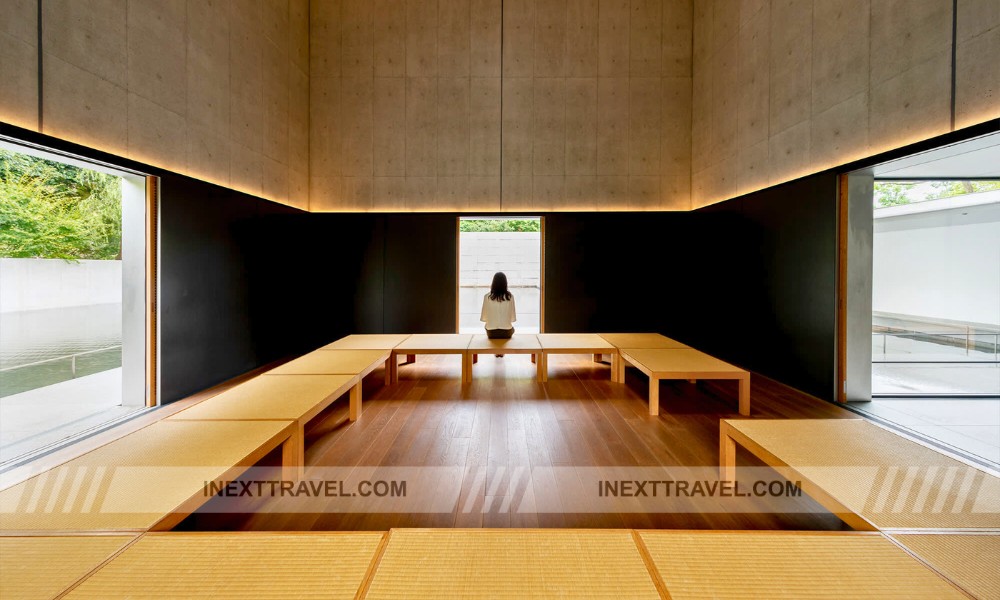
Visitors to the D.T. Suzuki Museum often comment on the transformative experience of walking through its spaces, where the architecture and the curated exhibits work together to inspire a state of Zen. Whether you are a follower of Zen Buddhism, a philosophy student, or someone searching for peace, the museum offers a rare opportunity to engage with profound spiritual and philosophical ideas in a setting that encourages deep thought and tranquility.
In conclusion, the D.T. Suzuki Museum is more than just a museum; it is a spiritual haven that offers each visitor an opportunity to embark on their journey of self-discovery and enlightenment, much like Suzuki himself did throughout his life. It is a significant cultural and philosophical landmark in Kanazawa, providing a considerable experience that resonates long after one has left its peaceful confines.
Number 3: Higashi Chaya District.
At number 3, the Higashi Chaya District is the largest and most picturesque of Kanazawa’s traditional chaya or teahouse districts. As one of the city’s cultural jewels, this beautifully preserved area offers a vivid glimpse into the geisha culture of the Edo period, meticulously maintained to capture the historical ambiance and artistic spirit of its prime.
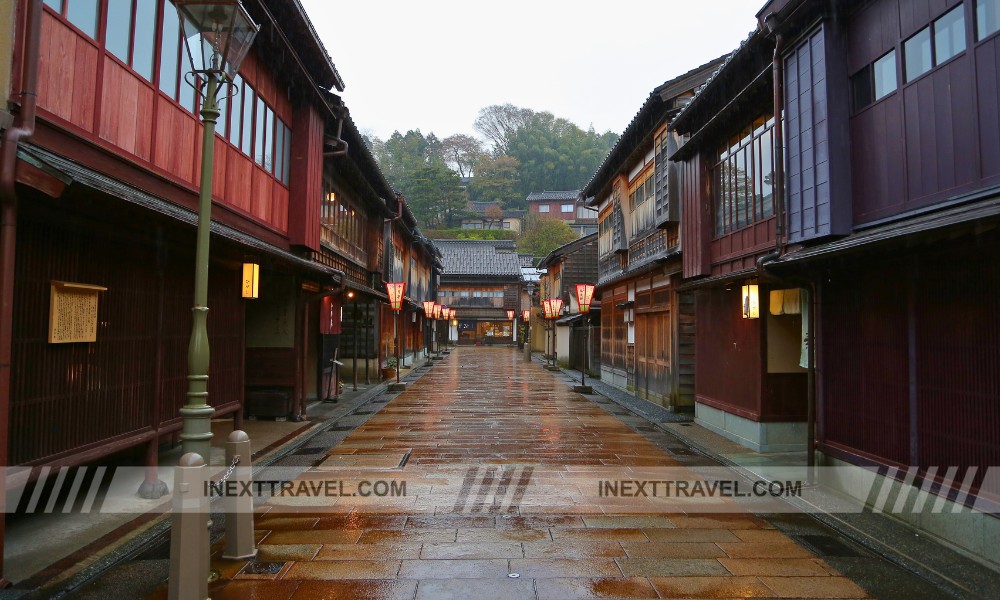
The Higashi Chaya District is characterized by its charming, narrow cobblestone streets lined with wooden-latticed buildings. Initially built in the 1820s, these structures house various teahouses where geishas have performed for centuries. Many of these establishments still function as exclusive venues where guests can enjoy traditional geisha entertainment, including dances, music, and games, all conducted in the refined and graceful manner of geisha culture.
Visitors to the district can also partake in other cultural experiences, such as trying on a kimono, wearing traditional Japanese attire, or participating in a tea ceremony. The tea ceremonies in the Higashi Chaya District are particularly memorable. They are conducted in historic teahouses that serve matcha (powdered green tea) and traditional Japanese sweets. This ritual is a cultural experience and an introduction to the ceremonial practices that play a central role in Kanazawa’s history and aesthetics.
Several of the district’s former teahouses have been converted into museums and craft shops open to the public. These shops allow visitors to explore the interiors of these historic buildings and learn more about their history and the lives of the people who worked and frequented them. These shops often sell local crafts, including gold leaf products, which Kanazawa is renowned for, providing visitors with a unique opportunity to take home a piece of Kanazawa’s artisanal heritage.
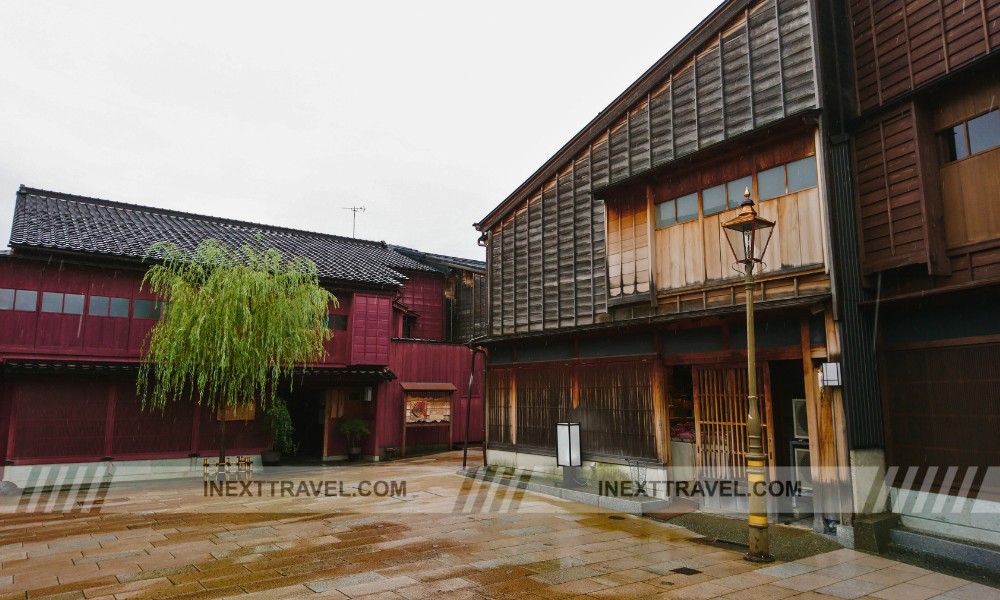
The Higashi Chaya District is more than just a historical site; it is a living neighborhood where the traditional and the contemporary meet. Modern cafes and boutiques coexist with conventional teahouses, offering a blend of old and new that encapsulates the spirit of Kanazawa. Walking through the district is like stepping back in time, yet the vitality of current-day activities ensures that the culture remains vibrant and accessible.
In conclusion, the Higashi Chaya District is an essential visit for anyone coming to Kanazawa, providing an immersive experience of the traditional arts, architecture, and hospitality that define this region. It stands as a testament to Kanazawa’s dedication to preserving its cultural heritage while continuing to breathe new life into its ancient traditions.
Number 2: Kenrokuen Garden.
Coming in at number 2, Kenrokuen Garden is not just a garden but a masterpiece of landscape design, widely celebrated as one of Japan’s top three most beautiful gardens. Located in the heart of Kanazawa, Kenrokuen exemplifies the ideals of a perfect garden, showcasing attributes that Japanese garden designers have revered for centuries: spaciousness, seclusion, artifice, antiquity, water courses, and panoramas. Each of these characteristics comes together to create a garden that offers visitors a different beauty with every step in every season.
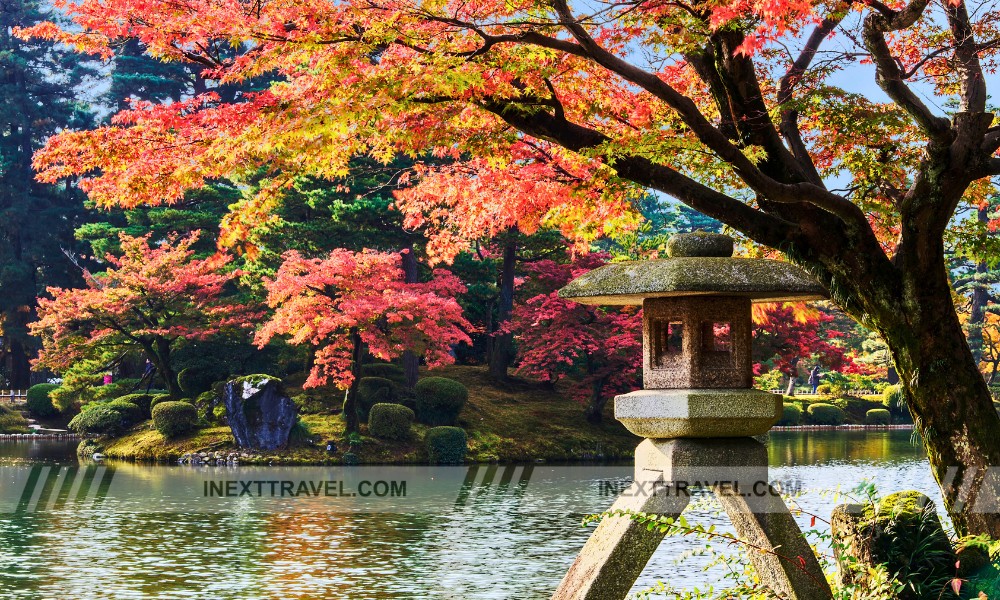
Kenrokuen was developed from the 1620s to the 1840s by the Maeda clan, the rulers of the Kaga Domain, and was originally the outer garden of Kanazawa Castle. It was opened to the public in 1871 and has since provided a stunning backdrop for relaxation and reflection. The garden covers over 11 hectares (28 acres), offering ample space for visitors to wander and explore its scenic vistas and hidden nooks.
The layout of Kenrokuen is carefully designed to emphasize natural landscapes while showcasing human ingenuity. It features a variety of ponds, streams, and waterfalls, all meticulously placed to capture the natural flow of water through the landscape. The largest pond, Kasumigaike, was meant to be admired from all angles, offering picturesque views that include the iconic Kotojitoro Lantern. This two-legged stone lantern has become a symbol of Kenrokuen and Kanazawa.
The garden’s manicured trees are another highlight, with careful pruning techniques applied to shape them into pleasing forms that change with the seasons. Perhaps the most famous is the Karasaki Pine, planted from seed by the 13th lord of the Maeda family. During winter, the branches of these trees are supported by ropes in a cone shape to prevent damage from heavy snow, creating a distinctive visual spectacle known as yukitsuri.
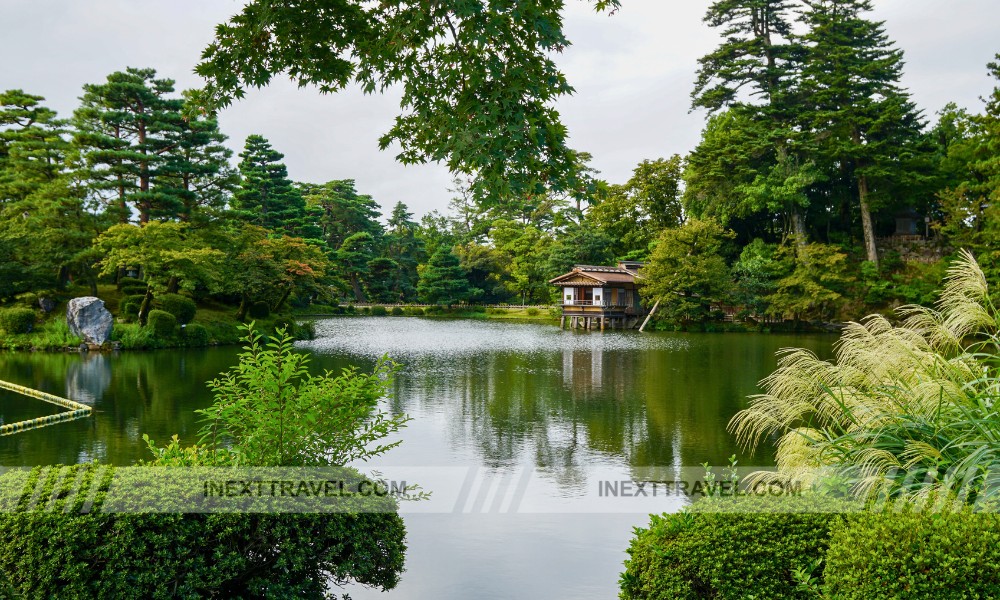
Seasonal changes transform Kenrokuen into a continuously evolving canvas. Spring brings a vibrant burst of cherry blossoms, summer clothes it in lush green, autumn drapes it in fiery hues, and winter covers it in a quiet blanket of snow, each season offering a unique experience of serene beauty.
In conclusion, Kenrokuen is not just a garden but a cultural treasure that embodies Japanese garden design’s sophisticated aesthetics and philosophical ideas. Its ability to evoke tranquility and dynamic yet harmonious landscapes make it an essential destination for anyone visiting Kanazawa. It offers a peaceful retreat from the modern world and a profound connection to nature’s artistry.
Number 1: 21st Century Museum of Contemporary Art.
At number one, the 21st Century Museum of Contemporary Art is a pinnacle of cultural innovation and aesthetic engagement in Kanazawa. This internationally acclaimed museum is renowned for its distinctive circular design and transparent walls, which create a seamless interaction between the interior spaces and the cityscape.
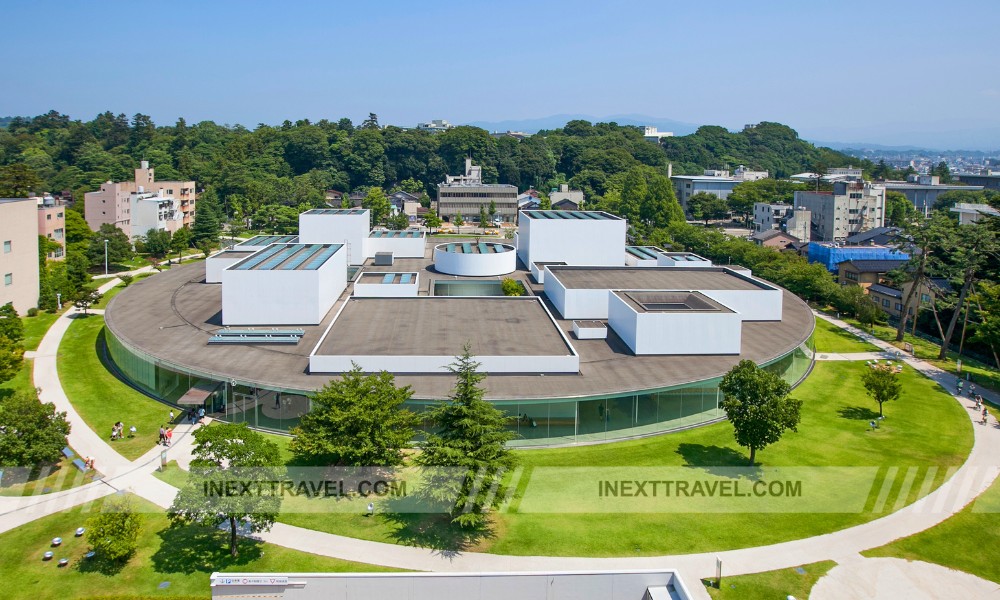
Designed by the acclaimed architectural firm SANAA, the museum’s unique layout encourages exploration and discovery, offering visitors a dynamic and immersive experience in contemporary art.
Since its opening in 2004, the 21st Century Museum of Contemporary Art has distinguished itself through its architecture and approach to curating and presenting contemporary art. The museum’s philosophy is to make art accessible to all, thereby democratizing the perceptions and experiences of modern works.
It achieves this by offering free zones within the museum, allowing casual visitors to engage with art without the barrier of an admission fee, and by organizing interactive installations that invite active participation rather than passive observation.
The museum hosts many exhibitions, from large-scale retrospectives of internationally renowned artists to experimental works by emerging talents. It is also home to some permanent installations that have become icons in their own right, such as Leandro Erlich’s “Swimming Pool” and James Turrell’s “Blue Planet Sky.” These play with perceptions of space and light, challenging visitors to reconsider their interactions with the familiar and the ordinary.
The 21st Century Museum of Contemporary Art also serves as a cultural hub in Kanazawa, offering various educational programs, artist talks, and workshops that enhance community engagement and foster a deeper understanding of contemporary artistic practices. These programs are designed to appeal to a broad audience, from art lovers and scholars to families and school groups, ensuring everyone can find something that resonates with them.
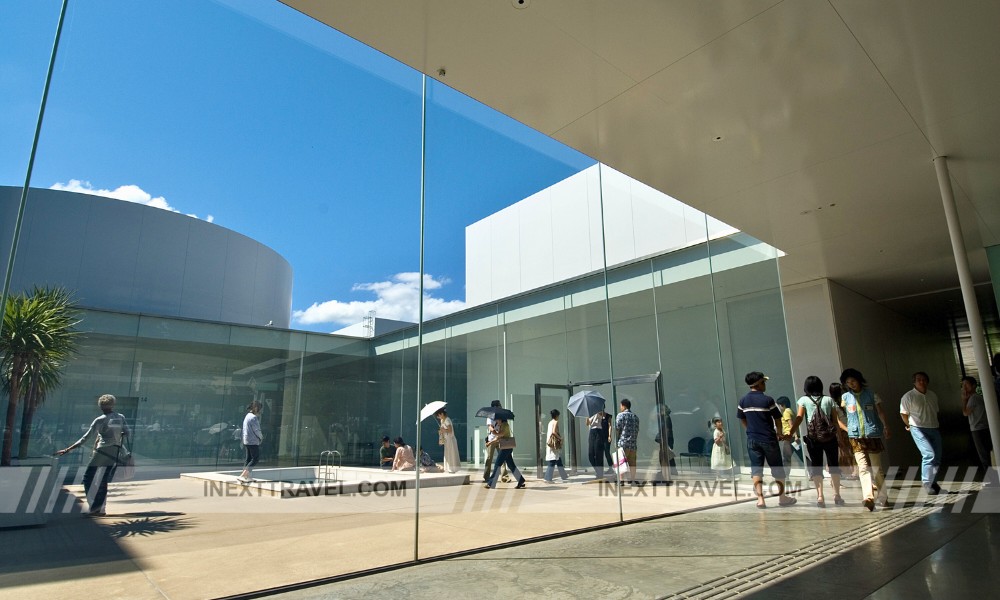
Moreover, the museum’s location in Kanazawa—a city known for its rich history and preserved traditional crafts—creates a fascinating dialogue between the old and the new, highlighting how contemporary cultural expressions can complement and draw from historical contexts. This juxtaposition makes the 21st Century Museum of Contemporary Art a critical destination for those looking to understand the evolving narrative of art in the modern world.
In conclusion, the 21st Century Museum of Contemporary Art is more than just a museum; it is a visionary space redefining the boundaries of art and architecture. With its innovative design and inclusive approach to art presentation, it stands as a must-visit destination in Kanazawa, promising enriching experiences that are both intellectually stimulating and visually captivating. Whether you are an art connoisseur or a curious visitor, this museum offers a fresh and engaging perspective on what contemporary art can be.
Conclusion
As our journey through Kanazawa ends, we hope you feel inspired to explore this city’s remarkable beauty and rich history.
From the tranquil elegance of Kenrokuen Garden to the innovative spirit of the 21st Century Museum of Contemporary Art, each destination on our list of the ten best beautiful places in Kanazawa offers a unique window into the city’s soul.
Whether you are drawn to the serene atmospheres of ancient gardens, the bustling energy of vibrant markets, or the thought-provoking exhibits of modern galleries, Kanazawa promises memorable experiences and breathtaking sights.
We invite you to walk its historic streets, engage with its art, and immerse yourself in the culture that makes Kanazawa a true gem of Japan.